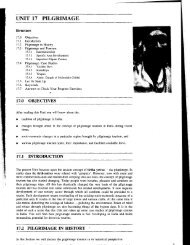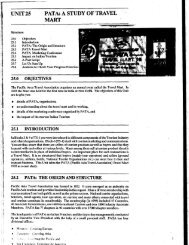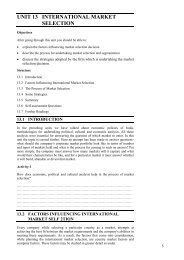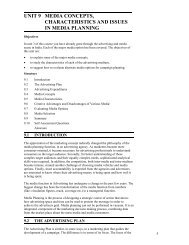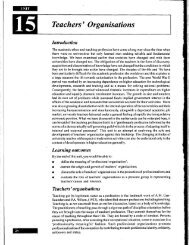UNIT 4 TOURISM AND CULTURE : SOME VIEWS - eGyanKosh
UNIT 4 TOURISM AND CULTURE : SOME VIEWS - eGyanKosh
UNIT 4 TOURISM AND CULTURE : SOME VIEWS - eGyanKosh
You also want an ePaper? Increase the reach of your titles
YUMPU automatically turns print PDFs into web optimized ePapers that Google loves.
Introducing Indian Cult= cultures exists in its richness and variety. Bali and 'Toraja are two of the most important places<br />
of tourist attraction. Tourists from many countries flock to these places to view the local<br />
festivals, rituds, ceremonies, dances, traditional arts and crafts and historical monuments.<br />
Initially, the influx of the tourists did not have much negative effects. But, with the passage of<br />
time and the increase in the number of tourists, many problems started emerging. In Toraja,<br />
the increase in the touribt traffic was sudden and the results more alarming. Basing on his<br />
study in 1976, Eric Crystal points out :<br />
"Tana Toraja may be unzque, and worthy of on-going careful study, because of the dramatic<br />
change within two years. The area has passed directly from the obscurity of elite, ethnic<br />
tourism to hecome a target for cultural, charter tourism without passing through any of the<br />
intermediary stages. It is too soon to fully assess the touristic impact, but some trends are<br />
evident. 'The local T'orajas are bewildered, and uncertain as to the choices open to them, or<br />
iheir outcome :<br />
I) If they open their villages, and their ceremonies, to tourism for the sake of economic gain,<br />
they are victimized by the compromise of cultural integrity;<br />
2) If they exclude the tourists, they are victimized by the inflation accompanying the influx,<br />
and enterprising neighbors reap the profits. Cultural conservatism does not 'pay'. During<br />
the tourist season of 1976 it was evident that rituals were being commercialized as<br />
'spectacles' for the foreigners, including being rescheduled at the request of foreign<br />
guides. Further, the disappearance of antiquities into the souvenir market indicated<br />
another potential cultural loss. My cautious optimism based on the 1974 data is strained,<br />
and further field research is needed. If, as anthropologists, WE have the capacity to guide,<br />
our skills should be applied here and now lest this fragile mountain community, which<br />
has o~lly its cultllral traditions to attract tourism, !oses both its heritage and the to~rists."<br />
On his subsequent visits to the area, the author recorded that while in 1975, the number of<br />
tourists to Toraja was only about 2500, by 1985 the number had increased to almost 40,000.<br />
This led to many changes. It has benefitted the people of the area in following ways :<br />
i) It has generated thousands of jobs for the locals and the infrastructural facilities in terms<br />
of roads and airstrips.<br />
ii) The economic and socio-political isolation of the region has now ended and the Torajan<br />
Culture, "once spoken of in derogatory terms, is now featured nationally in Indonesia as<br />
a major and important component of multicultural Indonesia."<br />
ui) The traditional Toraja crafts of weaving, ikat dyeing and he;idvr.cark haw found new and<br />
rich buyers and this has led to an improvement in the skills.<br />
These are some of the positive effects brc~ught about by the growth of tourism. But the<br />
traditional culture, life-styles and monuments have been victims of an unrestricted tourist<br />
growth. Eric Crystal says:<br />
"One of the sadder conseiuences of change in Toraja has bezn the accelerated loss of these<br />
precious heirlooms and cultural artifacts. Thert: is no doubt that tourism has played a<br />
significant role in this process. In 1969 beautiful strands of ancient beads were sold in each<br />
Toraja market by itinerant vendors. By 1976 villagers in the marketplace and the vendors<br />
themselves reported that such old beads were becoming increasingly scarce due to demand<br />
by visiting French tourists. By 1983 such beads were 'effectively' gone in the sense that they<br />
were out of the price range of the average village consumer. Tourists and itinerant<br />
international art dealers have demonstrated an insatiable appetite for old pieces of Toraja<br />
folk art. Newly crafted house panels, baskets, textiles, or carvings do not satisfy these most<br />
particular appetites; only the oldest, most weathered acd most exotic-looking pieces will do<br />
"Most devastating to the people of Toraja is the rape of ancestral statuary that continue<br />
unabated at this writing. The carving of ancestral images is common in a numher of relative1<br />
isolated cuiture regions of Indonesia and, indeed, was highly developed in many parts of th<br />
ancient world. Tau tau, or funerary statues, in Tana Toraja are carved of extremely durable<br />
jackfruit wood. Only the largest death ceremonies are embellished with a near life-sized<br />
wooden image of the deceased. After interment of the deceased in a limestone cave vault,<br />
the statue is placed in a gallery near the burial site. In 1969, two years before the first<br />
depredations were recorded, Tana Toraja preserved literally thousands of such statues in<br />
burial sites spread over much of its 3000 square kilometers of territory. When my fvst article








